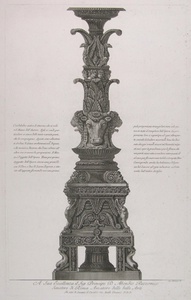| Method | Etching |
| Artist | Giovanni Battista Piranesi |
| Published | [Firmin-Didot, Paris, 1836] |
| Dimensions | Image 635 x 210 mm, Plate 680 x 420 mm, Sheet 785 x 550 mm |
| Notes |
Plate 27 of Vasi, candelabri, cippi, sarcofagi, tripodi, lucerne, ed ornamenti antichi disegnati ed incisi dal Cav. Gio. Batt. Piranesi, depicting a marble candelabrum ornately decorated with dolphins, harpies, horned satyr-heads, eagles, and thunder-bolts. At the centre, a large garlanded bull's head is flanked by twin roaring lions, which support the acanthus stem of the candelabrum's bowl. Like most of the works featured in the Vasi, candelabri, cippi..., this candelabrum purports to be constructed of fragments of antique marble. The plate is dedicated to His Excellency Abondio Rezzonico, 'Senator of Rome and Lover of the Fine Arts.' Abondio, like Piranesi's patron Pope Clement XIII, was a scion of the powerful Rezzonico family. The Vasi, candelabri, cippi, sarcofagi, tripodi, lucerne, ed ornamenti antichi disegnati ed incisi dal Cav. Gio. Batt. Piranesi was published in two volumes in 1778, and collected together a range of single plates that Piranesi had issued over the preceding decade. As the title suggests, the work was a collection of detailed drawings of vases, funeral monuments, and various ornaments, intended as much as a seller's catalogue as an exercise in antiquarian illustration. Piranesi's collaborations with notable dealers of antiquities like Gavin Hamilton and Thomas Jenkyns meant that his skills as a restorator, decorator, and dealer in his own right were in high demand. Many of the antiquities featured in the Vasi, Candelabri, cippi... made their way into the collections of British grand tourists, as the dedications on the plates suggest. Giovanni Battista (also Giambattista) Piranesi (1720 – 1778) was an Italian artist famous for his etchings of Rome and of fictitious and atmospheric "prisons" (the Carceri d'Invenzione). He was a major Italian printmaker, architect and antiquarian. The son of a Venetian master builder, he studied architecture and stage design, through which he became familiar with Illusionism. During the 1740's, when Rome was emerging as the centre of Neoclassicism, Piranesi began his lifelong obsession with the city's architecture. He was taught to etch by Giuseppe Vasi and this became the medium for which he was best known. Wilton-Ely 912, F625, C533 Ex collection: Sir Howard Colvin Condition: Foxing to margins and right side of plate not affecting image, pressed centre fold. Otherwise good clean impression with full margins. |
| Framing | unmounted |
| Price | £1,000.00 |
| Stock ID | 13479 |

